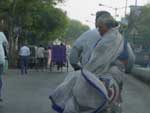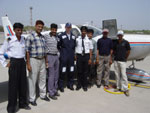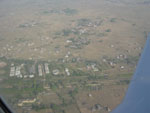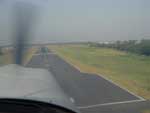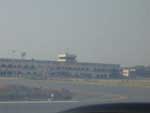

75
DAYS TO GO
![]()
DONATE
| HOME |
| DIARY |
| ROUTE |
| SPONSORS |
| PRESS ROOM |
| BREMEN FLIGHT |
| CHARITY |
| THE AIRCRAFT |
| THE PILOTS |
| CONTACT US |
© Copyright World Flight 2002
|
May 16th -
Ahmedabad, India to Patna, India Prior to
traveling to India we had expected this to be the most expensive
place for landing and ground handling services. Handling fees
can be up to $1100 for one night. Advice from Flemming Pederesen,
a Swiss pilot who flew around the world in 2000 We had hoped to get airborne from Ahmedabad 8am but with the long paperwork process we didn't get going until 11.30. We wanted to get going as early as possible - the later we left it the hotter it got and the performance of the aircraft would suffer in the heat (not to mention the reduced performance of the pilots in this heat). At 11.30am the temperature was already over 40 degrees and cumulus (Cu) clouds were popping up all over the sky indicating a bumpy flight. We had taken extra fuel for the flight so we were heavy. Adding an extra 10 knots onto our rotate speed due to our weight and the heat we climbed slowly into the sky leaving Ahmedabad behind us. At times our rate of climb was down to 300 feet per minute as we climbed to 7,000 feet. In the cruise the thermals were awful, we were being kicked around the sky, one minute we would fly into an updraft and have a rate of climb of over 2,000 feet a minute (off the scale of our VSI instrument) - we fought to stop the climb but it became impossible to maintain 7,000 feet so we tried higher looking for smoother air. The downdrafts were just as bad, with the nose of the aircraft high in the air, full power at 80 knots we were still descending at rates of up to 1500 feet per minute. In a short time we were up at Flight Level 110 (11,000 feet) where we hoped we could climb above the turbulence. It wasn't much better here and as we have no oxygen we fought hard to stop the thermals taking us higher. At this level we encountered a stronger headwind as well which slowed our progress. These were the strongest thermals and worst turbulence we had ever experienced. Any higher then 11,000 feet and the risk of Hypoxia increases (lack of oxygen which puts you in a euphoric state before falling into unconsciousness). A sign of Hypoxia, is your finger nails showing a blue tinge- we keep a check on how we are doing at 11,000 feet but all looks well. As we are spending so much time flying up around 11,000 feet we are taking Aspirin before and after flights which has the effect of thinning the blood and helps prevent Thrombosis. Food on board today was limited to a pack of "Hob Nob" biscuits and two bottles of water. This was all we had for the 5 hour flight but it was better than nothing. Our routing was near enough direct to Patna via the VOR beacons onroute. We navigate by selecting beacons in our Navigation radio in the aircraft, dialing in the radial (track) we want to fly and a needle indicates which way to fly to reach the beacon. We also have DME (indicates distance from the beacon). Backing this up we have GPS in the aircraft and another handheld GPS (with moving map display) to triple check everything. GPS makes life so much easier as our estimated time of arrival at each of the points on our route is indicated on the GPS as well updated constantly. As we fly for a few hours the turbulence reduces and we settle into the flight. On of our jobs is to monitor the fuel flow. We estimate fuel remaining by working out the number of minutes burning fuel from each tank. The Piper Cherokee has 4 separate tanks (no cross feed between tanks) so you have to carefully work out how much is left in each tank. We also have our auxiliary fuel tank to give us the extra range with an endurance of over 15 hours. There is no high tech gadget to manage the fuel other than our notebook and pen. Patna town comes into view 8 hours later. We were cleared to the VOR beacon at the airfield and then to fly the procedure (VOR/DME) for landing but as we got closer we were setup on a straight in approach and we opted to go visual. The landing was smooth and we taxied over to our stand were customs were again waiting to meet us. The long paper trail was about to start again. Tomorrow we leave for Thailand - we are both exhausted from flying every day for the last 4 days, looking forward to a break in Chiang Mai. |
|
